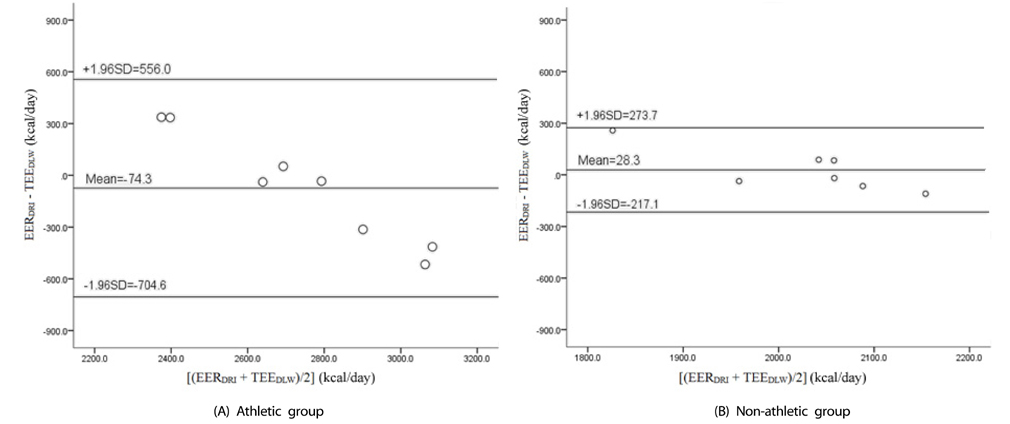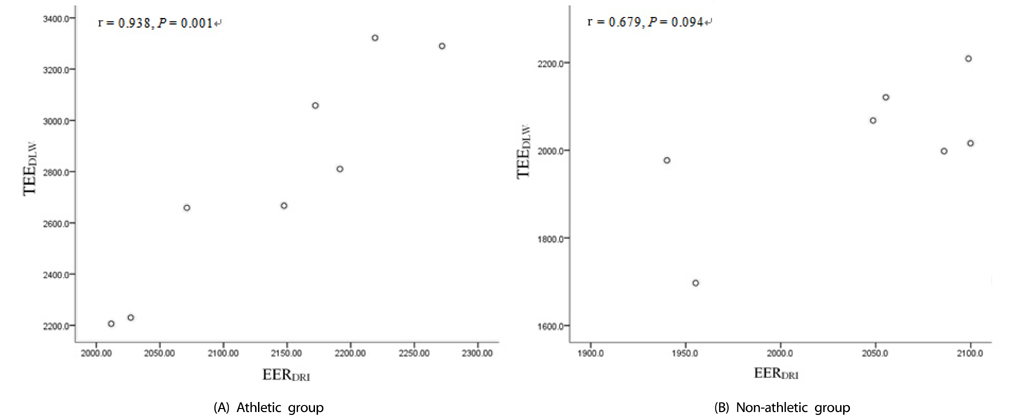Nutr Res Pract.
2017 Feb;11(1):51-56. 10.4162/nrp.2017.11.1.51.
Accuracy of dietary reference intake predictive equation for estimated energy requirements in female tennis athletes and non-athlete college students: comparison with the doubly labeled water method
- Affiliations
-
- 1Department of Food and Nutrition, Gangneung-Wonju National University, 120 Gangneungdaehangno, Gangneung, Gangwon 25457, Korea. ekkim@gwnu.ac.kr
- 2Department of Nutritional Education, National Institute of Health and Nutrition, Tokyo 162-8636, Japan.
- 3Department of Physical Education, Korea University, Seoul 02841, Korea.
- KMID: 2395293
- DOI: http://doi.org/10.4162/nrp.2017.11.1.51
Abstract
- BACKGROUND/OBJECTIVES
The purpose of this study was to assess the accuracy of a dietary reference intake (DRI) predictive equation for estimated energy requirements (EER) in female college tennis athletes and non-athlete students using doubly labeled water (DLW) as a reference method.
MATERIALS/METHODS
Fifteen female college students, including eight tennis athletes and seven non-athlete subjects (aged between 19 to 24 years), were involved in the study. Subjects' total energy expenditure (TEE) was measured by the DLW method, and EER were calculated using the DRI predictive equation. The accuracy of this equation was assessed by comparing the EER calculated using the DRI predictive equation (EER(DRI)) and TEE measured by the DLW method (TEE(DLW)) based on calculation of percentage difference mean and percentage of accurate prediction. The agreement between the two methods was assessed by the Bland-Altman method.
RESULTS
The percentage difference mean between the methods was -1.1% in athletes and 1.8% in non-athlete subjects, whereas the percentage of accurate prediction was 37.5% and 85.7%, respectively. In the case of athletic subjects, the DRI predictive equation showed a clear bias negatively proportional to the subjects' TEE.
CONCLUSIONS
The results from this study suggest that the DRI predictive equation could be used to obtain EER in non-athlete female college students at a group level. However, this equation would be difficult to use in the case of athletes at the group and individual levels. The development of a new and more appropriate equation for the prediction of energy expenditure in athletes is proposed.
Keyword
MeSH Terms
Figure
Cited by 2 articles
-
Validation of dietary reference intake equations for estimating energy requirements in Korean adults by using the doubly labeled water method
Eun-Kyung Kim, Jae-Hee Kim, Myung-Hee Kim, Didace Ndahimana, Seo-Eun Yean, Jin-Sook Yoon, Jung-Hyun Kim, Jonghoon Park, Kazuko Ishikawa-Takata
Nutr Res Pract. 2017;11(4):300-306. doi: 10.4162/nrp.2017.11.4.300.Measurement Methods for Physical Activity and Energy Expenditure: a Review
Didace Ndahimana, Eun-Kyung Kim
Clin Nutr Res. 2017;6(2):68-80. doi: 10.7762/cnr.2017.6.2.68.
Reference
-
1. American Dietetic Association. Dietitians of Canada. American College of Sports Medicine. Rodriguez NR, Di Marco NM, Langley S. American College of Sports Medicine position stand. Nutrition and athletic performance. Med Sci Sports Exerc. 2009; 41:709–731.2. Ranchordas MK, Rogersion D, Ruddock A, Killer SC, Winter EM. Nutrition for tennis: practical recommendations. J Sports Sci Med. 2013; 12:211–224.3. Manore MM. Weight management for athletes and active individuals: a brief review. Sports Med. 2015; 45:Suppl 1. S83–S92.
Article4. Łagowska K, Kapczuk K, Friebe Z, Bajerska J. Effects of dietary intervention in young female athletes with menstrual disorders. J Int Soc Sports Nutr. 2014; 11:21.
Article5. Márquez S, Molinero O. Energy availability, menstrual dysfunction and bone health in sports; an overview of the female athlete triad. Nutr Hosp. 2013; 28:1010–1017.6. Park J, Kazuko IT, Kim E, Kim J, Yoon J. Estimating free-living human energy expenditure: practical aspects of the doubly labeled water method and its applications. Nutr Res Pract. 2014; 8:241–248.
Article7. Institute of Medicine of the National Academies (US). Dietary Reference Intakes for Energy, Carbohydrate, Fiber, Fat, Fatty Acids, Cholesterol, Protein, and Amino Acids (Macronutrients). Washington (D.C.): The National Academies Press;2002.8. Ministry of Health and Welfare (KR). The Korean Nutrition Society. Dietary Reference Intakes for Koreans 2015. Sejong: Ministry of Health and Welfare;2016.9. Silva AM, Santos DA, Matias CN, Minderico CS, Schoeller DA, Sardinha LB. Total energy expenditure assessment in elite junior basketball players: a validation study using doubly labeled water. J Strength Cond Res. 2013; 27:1920–1927.10. Tooze JA, Schoeller DA, Subar AF, Kipnis V, Schatzkin A, Troiano RP. Total daily energy expenditure among middle-aged men and women: the OPEN study. Am J Clin Nutr. 2007; 86:382–387.
Article11. Bandini LG, Lividini K, Phillips SM, Must A. Accuracy of dietary reference intakes for determining energy requirements in girls. Am J Clin Nutr. 2013; 98:700–704.
Article12. Weir JB. New methods for calculating metabolic rate with special reference to protein metabolism. J Physiol. 1949; 109:1–9.
Article13. Bhutani S, Racine N, Shriver T, Schoeller DA. Special considerations for measuring energy expenditure with doubly labeled water under atypical conditions. J Obes Weight Loss Ther. 2015; 5:002.
Article14. Taaffe DR, Thompson J, Butterfield G, Marcus R. Accuracy of equations to predict basal metabolic rate in older women. J Am Diet Assoc. 1995; 95:1387–1392.
Article15. Bland JM, Altman DG. Statistical methods for assessing agreement between two methods of clinical measurement. Lancet. 1986; 1:307–310.
Article16. Ribeyre J, Fellmann N, Montaurier C, Delaître M, Vernet J, Coudert J, Vermorel M. Daily energy expenditure and its main components as measured by whole-body indirect calorimetry in athletic and non-athletic adolescents. Br J Nutr. 2000; 83:355–362.17. Petridou A, Lazaridou D, Mougios V. Lipidemic profile of athletes and non-athletes with similar body fat. Int J Sport Nutr Exerc Metab. 2005; 15:425–432.
Article18. Santos DA, Silva AM, Matias CN, Magalhães JP, Fields DA, Minderico CS, Ekelund U, Sardinha LB. Validity of a combined heart rate and motion sensor for the measurement of free-living energy expenditure in very active individuals. J Sci Med Sport. 2014; 17:387–393.
Article19. Stickler L, Hoogenboom BJ, Smith L. The female athlete triad-what every physical therapist should know. Int J Sports Phys Ther. 2015; 10:563–571.20. Rosenkilde M, Morville T, Andersen PR, Kjær K, Rasmusen H, Holst JJ, Dela F, Westerterp K, Sjödin A, Helge JW. Inability to match energy intake with energy expenditure at sustained near-maximal rates of energy expenditure in older men during a 14-d cycling expedition. Am J Clin Nutr. 2015; 102:1398–1405.
Article21. St-Onge MP, Roberts AL, Chen J, Kelleman M, O'Keeffe M, RoyChoudhury A, Jones PJ. Short sleep duration increases energy intakes but does not change energy expenditure in normal-weight individuals. Am J Clin Nutr. 2011; 94:410–416.
Article22. Zamora-Salas JD, Laclé-Murray A. Validation of total daily energy expenditure calculated with actiheart against doubly labeled water method in Costa Rican schoolchildren. Food Nutr Sci. 2015; 6:1193–1201.
- Full Text Links
- Actions
-
Cited
- CITED
-
- Close
- Share
- Similar articles
-
- Validity of the dietary reference intakes for determining energy requirements in older adults
- Validation of dietary reference intake equations for estimating energy requirements in Korean adults by using the doubly labeled water method
- Accuracy of 24-hour Diet Recalls for Estimating Energy Intake in Elderly Men using the Doubly Labeled Water Method
- A narrative review on the application of doubly labeled water method for estimating energy requirement for Koreans
- Estimating free-living human energy expenditure: Practical aspects of the doubly labeled water method and its applications



